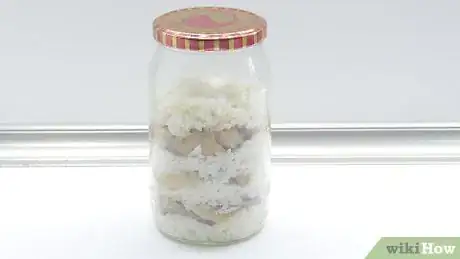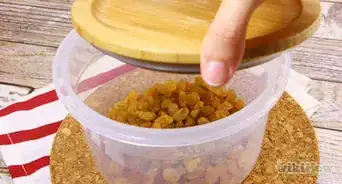This article was co-authored by wikiHow staff writer, Jessica Gibson. Jessica Gibson is a Writer and Editor who's been with wikiHow since 2014. After completing a year of art studies at the Emily Carr University in Vancouver, she graduated from Columbia College with a BA in History. Jessica also completed an MA in History from The University of Oregon in 2013.
The wikiHow Culinary Team also followed the article's instructions and verified that they work.
This article has been viewed 13,132 times.
Learn more...
You might be surprised to learn that cultures all over the world have methods for fermenting fish. This is because packing the fish in salt or rice and fermenting it preserves the fish. It also creates food with incredible umami flavor. If you enjoy eating the fish without cooking it, ferment it in a seasoned brine. To make fermented fish into a flavorful meal, ferment it in salt and rice. This way, you can cook the mixture with vegetables to make a hearty meal.
Ingredients
- 3 to 4 fresh herring, sardines, mackerel, or any available fresh fish
- 2 to 3 slices of white onion
- 1/2 teaspoon (1 g) of coriander seeds
- 10 bay leaves
- 1 teaspoon (2 g) of black peppercorns
- 1 sprig of fresh dill
- 2 cups (470 ml) of water
- 1 tablespoon (17 g) sea salt
- 3 to 4 tablespoons (44 to 59 ml) of whey from yogurt or kefir
Makes a 1 US quart (0.95 L) jar of fish
- 2 cups (400 g) of cooked rice, cold
- 2 tablespoons (65 g) of rock salt, divided
- 2 tilapia, salmon, trout fillets, or 3⁄4 pound (340 g) of silver biddies
- 2 tomatoes, chopped, for serving
- 3 cloves of garlic, chopped, for serving
- 1 onion, sliced, for serving
- 1⁄2 cup (120 ml) of water
Makes 2 to 4 servings
Steps
Fermented Fish in Salt
-
1Skin 3 to 4 fish and remove the bones. You can use this recipe as a way to ferment any type of fish that you want to preserve. For example, get out 3 or 4 fresh herring, sardines, or mackerel to use. Then, use a sharp knife to remove the skin and de-bone the fish.[1]
- Feel free to substitute your favorite type of fish. You can use any de-boned fillet of fish.
-
2Chop the fish into bite-sized pieces and put them into a 1 US qt (0.95 L) jar. Get out a clean, sterilized jar that's large enough to hold the fish. Then, roughly chop them—they don't have to be perfectly uniform—and put them in the jar.[2]Advertisement
-
3Add onion, coriander, bay leaves, peppercorns, and dill. Put a few slices of white onion into the jar with the fish along with 1/2 teaspoon (1 g) of coriander seeds, 10 bay leaves, 1 teaspoon (2 g) of black peppercorns, and a sprig of fresh dill. These will all add incredible flavor to the fish as it ferments.[3]
- Some Baltic countries add a few crushed juniper berries and cardamom pods to add a unique flavor to the fish.
-
4Mix water with salt and whey in a separate bowl or jug. To get whey, drain a batch of homemade yogurt or kefir in cheesecloth and keep the liquid. Measure 3 to 4 tablespoons (44 to 59 ml) of this liquid whey and put it into a measuring jug along with 1⁄2 cup (120 ml) of cool water. Then, stir in 1 tablespoon (17 g) sea salt until it dissolves.[4]
- Making homemade yogurt or kefir can feel like a lot of work. For less effort, you can buy plain yogurt and use the liquid that settles on the top.
-
5Pour the brine into the jar to submerge the fish. The salt and whey in the mixture will preserve and season the fish. If you don't have enough brine to completely cover the fish, pour in more cool water.
-
6Seal the jar and leave the fish at room temperature for 3 to 5 days. Screw the lid on tightly and label the jar so you know when you started fermenting the fish. Set the jar at room temperature where it's out of direct sunlight and leave it for at least 3 days or up to 5.[5]
-
7Move the jar to the fridge and use the fermented fish within a few days. The fish will continue to ferment, so you can slow down the process by putting it into the fridge. Then, plan on eating it within a few days. Try eating it with slices of avocado and onion. It's also great mixed with crème fraiche and a squeeze of lemon![6]
- Most people prefer to eat fermented fish without cooking it. Serve it with crackers or dry toast. It's also great with other pickled foods like pickled vegetables.
Fermented Fish with Rice (Burong Isda)
-
1Sterilize a 1 US quart (0.95 L) glass jar and lid. You can use a mason jar or a glass bottle that has a tight-fitting lid. Run them through the dishwasher on a high-heat setting to sterilize them.[7]
- Don't have a dishwasher? Put the jar or bottle and lid into a pot and fill it with enough water to submerge them. Then, boil the water over high heat for 10 minutes.
- Don't try to handle the hot, sterilized jar or bottle until it's cooled.
-
2Mix cold white rice in a bowl with 1 1/2 tablespoons (49 g) of rock salt. This is a great way to use leftover cooked rice you have in the fridge! Measure 2 cups (400 g) of cold, white rice and put it into a mixing bowl. Then, add 1 1/2 tablespoons (49 g) of rock salt and use your fingers or a spatula to work the salt throughout the rice.[8]
- If the cold rice sticks to your hands or the spatula, dip them in cold water.
-
3Cut the fish into bite-sized pieces if you're using fillets. Take 2 cleaned fillets of fish like tilapia, salmon, trout, or whatever fish is fresh in your area and chop them into rough pieces. Put the fish into a big bowl.[9]
- Want to use small, whole fish like silver biddies instead of fillets? No problem! You can skip this step and use 3⁄4 pound (340 g) of small, whole fish instead.
-
4Rub the remaining 1/2 tablespoon (16 g) of rock salt on the fish. Sprinkle the remaining rock salt over the chopped fish or small, whole fish in your bowl. Use your fingers to toss the fish so the salt coats it.[10]
- This probably seems like a lot of salt in addition to the salted rice, but remember that salt helps preserve the fish.
-
5Pack alternating 1 in (2.5 cm) layers of rice and fish in the jar. Spread about 1 inch (2.5 cm) of the salted rice in the bottom of your sterilized jar. Then, press a layer of fish pieces or small, whole fish over the rice. Pack another layer of rice over the fish and press down to get rid of air pockets. Keep alternating the layers until you've used all the fish and end with a rice layer.[11]
- Don't worry if you have space at the top of your bottle—you just don't want air pockets around the fish.
-
6Seal the jar tightly so air can't get into the container. If your jar has an airtight lid, screw it on so it's secure. If you're using a bottle that didn't come with one, no problem! Just press a piece of plastic wrap over the top and pop a rubber band on it so the plastic doesn't slide off.[12]
- If you really want to make sure that your jar is completely airtight, you can use plastic wrap and screw a lid on top of it.
-
7Put the jar in a cool, dry place to ferment for 7 to 10 days. Set the jar in a dark place where heat and light won't damage the fish. After a few days, you can open the jar and push the fish/rice mixture down so it's covered by the liquid that appears. Leave the fish to ferment for at least 7 days before you eat it. Don't forget about your fish! If you let it ferment for more than 10 days, it can spoil.[13]
- It's really easy to forget when you started fermenting the fish, so label the jar with the date.
-
8Sauté the fermented fish with vegetables when you're ready to eat it. Create a flavorful meal by cooking a sliced onion in a skillet with 2 chopped tomatoes and 3 chopped cloves of garlic. Once they're soft, stir in all of the fermented fish and rice. Then, mix in 1⁄2 cup (120 ml) of water and heat the dish until it simmers.[14]
- Stir in more water if you like your burong isda to be thinner.
- If you like a spicy meal, add a few thinly sliced pieces of fresh ginger when you sauté the veggies.
Expert Q&A
-
QuestionHow can you tell if fish is safe to eat?
 Abyssinia CampbellAbyssinia Campbell is an Executive Chef and the Owner of Chef Abyssinia, Personal Chef and Catering. With over ten years of experience, she specializes in catering, event planning, menu development, meal planning, and food business operations. When it comes to cooking, Chef Abyssinia enjoys using fruits, vegetables, healthy food alternatives, and local farm-fresh ingredients. She holds a BASc in Culinary Arts and Food Service Management from Johnson and Wales University.
Abyssinia CampbellAbyssinia Campbell is an Executive Chef and the Owner of Chef Abyssinia, Personal Chef and Catering. With over ten years of experience, she specializes in catering, event planning, menu development, meal planning, and food business operations. When it comes to cooking, Chef Abyssinia enjoys using fruits, vegetables, healthy food alternatives, and local farm-fresh ingredients. She holds a BASc in Culinary Arts and Food Service Management from Johnson and Wales University.
Executive Chef If you have a whole fish, the eyes will start to turn foggy gray if the fish is not really fresh. Also, it will start to smell and the skin will probably be slimy. Those are the most basic ways to identify if it is still safe to eat.
If you have a whole fish, the eyes will start to turn foggy gray if the fish is not really fresh. Also, it will start to smell and the skin will probably be slimy. Those are the most basic ways to identify if it is still safe to eat.
Warnings
- Work with clean, sterilized containers so you don't introduce harmful bacteria to the fermenting fish.⧼thumbs_response⧽
Things You'll Need
Fermented Fish in Salt
- 1 US quart (0.95 L) jar with lid
- Measuring cups and spoons
- Knife and cutting board
- Measuring jug
- Spoon
Fermented Fish with Rice (Burong Isda)
- 1 US quart (0.95 L) glass jar and lid
- Knife and cutting board
- Measuring cups and spoons
- Spatula
- Bowl
- Plastic wrap, optional
References
- ↑ https://www.epicurious.com/recipes/member/views/fermented-fish-52351871
- ↑ https://www.epicurious.com/recipes/member/views/fermented-fish-52351871
- ↑ https://www.epicurious.com/recipes/member/views/fermented-fish-52351871
- ↑ https://www.epicurious.com/recipes/member/views/fermented-fish-52351871
- ↑ https://chefmarian.com/ucsd-class-fermenting-vs-pickling/
- ↑ https://www.myfermentation.com/meat-and-fish/mackerel-zerz1906zsta
- ↑ https://amiablefoods.com/burong-isda/
- ↑ https://amiablefoods.com/burong-isda/
- ↑ https://amiablefoods.com/burong-isda/























































